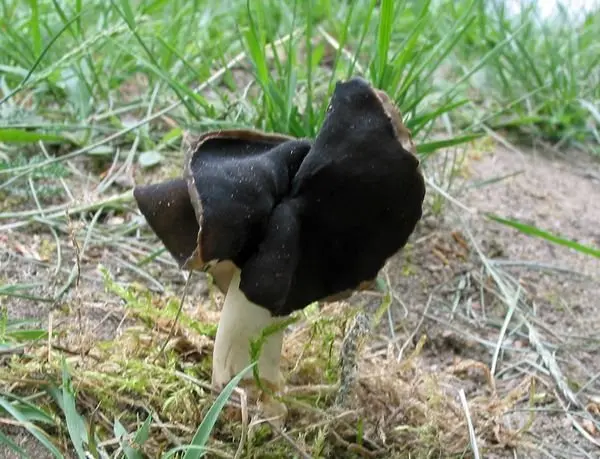White-legged lobe (Helvella spadicea)
- Department: Ascomycota (Ascomycetes)
- Subdivision: Pezizomycotina (Pezizomycotins)
- Class: Pezizomycetes (Pezizomycetes)
- Subclass: Pezizomycetidae (Pezizomycetes)
- Order: Pezizales (Pezizales)
- Family: Helvellaceae (Helwellaceae)
- Genus: Helvella (Helvella)
- Type: Helvella spadicea (White-legged lobe)
- Helvella leucopus

Hat: 3-7 cm wide and high, with three or more petals, but often with only two; of various shapes: in the form of a saddle from three different angles, and sometimes it is simply randomly curved; in young specimens, the edges are almost even, the lower edge of each petal is usually attached to the stem at one point. Surface more or less smooth and dark (from dark brown or grayish brown to blackish), sometimes with light brown spots. The underside is white or has a brightened color of the cap, with sparse villi.
Leg: 4-12 cm long and 0,7-2 cm thick, flat or thickened towards the base, often flattened, but not ribbed or grooved; smooth (not fleecy), often hollow or with holes at the base; white, sometimes with age a light smoky brown tint appears; empty in cross section; becomes dirty yellowish with age.
Pulp: thin, rather brittle, rather dense in the stem, without pronounced taste and smell.
Spore powder: whitish. Spores are smooth, 16-23*12-15 microns
Habitat: The white-legged lobe grows from May to October, singly or in groups in mixed and coniferous forests, on the soil; prefers sandy soils.
Edibility: like all representatives of this genus, the white-legged lobe is conditionally edible, poisonous in its raw form, and therefore requires a long heat treatment. Edible after boiling for 15-20 minutes. In some countries it is used in traditional cooking.
Related types: similar to Helvella sulcata, which, unlike Helvella spadicea, has a clearly ribbed stalk, and can also be confused with Black Lobe (Helvella atra), which has a gray to black stalk.









